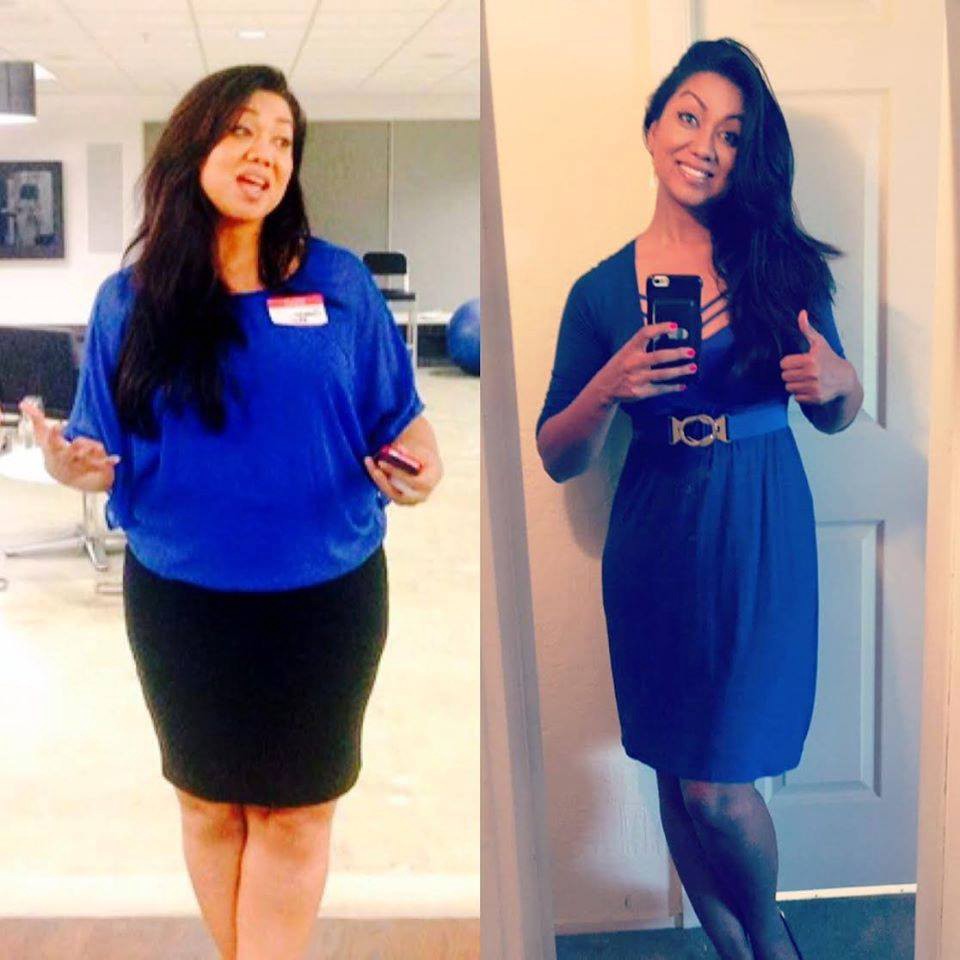 My stats: I?m 5’6.5″ I started at 205 pounds (left) and 7.5 months later at 155 pounds (right).
My stats: I?m 5’6.5″ I started at 205 pounds (left) and 7.5 months later at 155 pounds (right).
Updates [August 2020]:
- This guide has now passed 1,800,000 views! Big thank you to everyone who continues to share it ?
- I?ve now lost 65 lbs to-date! Follow me on Instagram (@sumayakazi) to see my day-to-day journey with Intermittent Fasting & get tips/advice.
- Interested in fasting with me? ?? Join my 30-day Starter Challenge or 8-week Lifestyle Challenge & optional private Facebook group. Nearly 2,000 people have completed it! Next kickoff is on Monday, learn more: http://bit.ly/fastchallenge
- I was interviewed by Megyn Kelly live on The TODAY Show about my Intermittent Fasting Journey. It?s one of the most-watched videos on YouTube on the topic with nearly 3,000,000 views. You can watch it here!
Hi there ??? My name is Sumaya and thanks to Intermittent Fasting (or IF for short), in 7.5 months I?ve dropped 50 pounds, 10.5% in body fat and 40 inches around my body. These results are entirely as a result of IF as I was unable to exercise for the first several months due to a fractured foot.
After college, I spent at least 5+ years in the overweight category (no thanks to bad habits, traveling and eating out) before spending another 5+ years in the obese category (no thanks to ?startup stress?, late nights and even more work travel). I?m now officially in the normal weight category (according to my BMI).
I tried everything from Jenny Craig/Weight Watchers to going to the gym 4?5x a week to weekly meal prep. While I did see some results, I eventually couldn?t keep up with it and then yo-yo?d. IF has been the simplest and most manageable way I have found to improve my health (and stick with it).
This post is intended for my friends (and friends of friends) who have been following my health journey on Instagram, Facebook, Snapchat or and have asked how to get started. Because the interest has been in the thousands (so amazing!), I?ve decided to share this information more publicly.
In the interest of time, I?ve created this super quick start guide. In the near future, I?ll be sharing more details, providing tips and answering the most commonly asked questions I get.
The parts I?ve highlighted in italics below are areas I plan to elaborate on in future posts. Again, this is meant to be a quick start guide. If you have specific questions, please do comment below or message me on Instagram or Facebook, or Snapchat.
If you find this guide useful, please tap the ? button below!
My Quick Start Guide to Intermittent Fasting
What is Intermittent Fasting?
Fasting has been around for thousands of years and commonly practiced in major religions and utilized by medical practitioners.
There are many studies documenting the benefits of fasting which include lowering the risk of type 2 diabetes, reducing cholesterol levels, enhancing the body?s resistance to oxidative stress (which is connected to aging and many chronic diseases), reducing inflammation (a key driver in many common diseases) and? weight loss! The weight loss benefit is how I first got introduced to Intermittent Fasting (or IF for short).
Like most other approaches to weight loss, the overall goal is to reduce calories without malnutrition. However, compared to the other approaches, Intermittent Fasting is focused on *when* to eat and when not to.
There are many different kinds of IF but for this quick start guide, I will be sharing the style I?ve adopted and has worked for me.
Before you start Intermittent Fasting
I know many of you are itching to get started right away, but IF is not for everyone. It is not recommended for pregnant women, women who are breastfeeding, people with diabetes, or other people who need to closely regulate their blood sugar. In addition, there has not been research on participants who are underweight, very old, or very young (<18 yrs. old) and these populations could be at higher risk for experiencing negative consequences of fasting (Longo and Mattson , 2014). So please:
- Visit your doctor and share your interest in IF. Make sure it?s right for you.
- Research more about IF and learn outside of what I share to see if there is a different style of IF that is a better fit for you and your needs. While there is widely available research on the benefits of IF, you should also learn more about the potential of negative effects of fasting on sleep, alertness, cognitive-motor performance, mood and for those with a previous history or susceptibility with eating disorders.
- If you want to understand how full day fasts work (and the science behind it), check out the BBC documentary ?Eat, Fast & Live Longer.? It focuses on a style called Alternate Day Fasting. This documentary helped me in deciding to try IF as a lifestyle.
- Check out my friend Daniel?s journey in IF. I?ve been grateful for his early support and guidance in adopting this life changing lifestyle. His journey in losing 60+ pounds was what initially got me interested in researching IF, and I found comfort in knowing someone who had success with it.
Measurements & Tools I Use
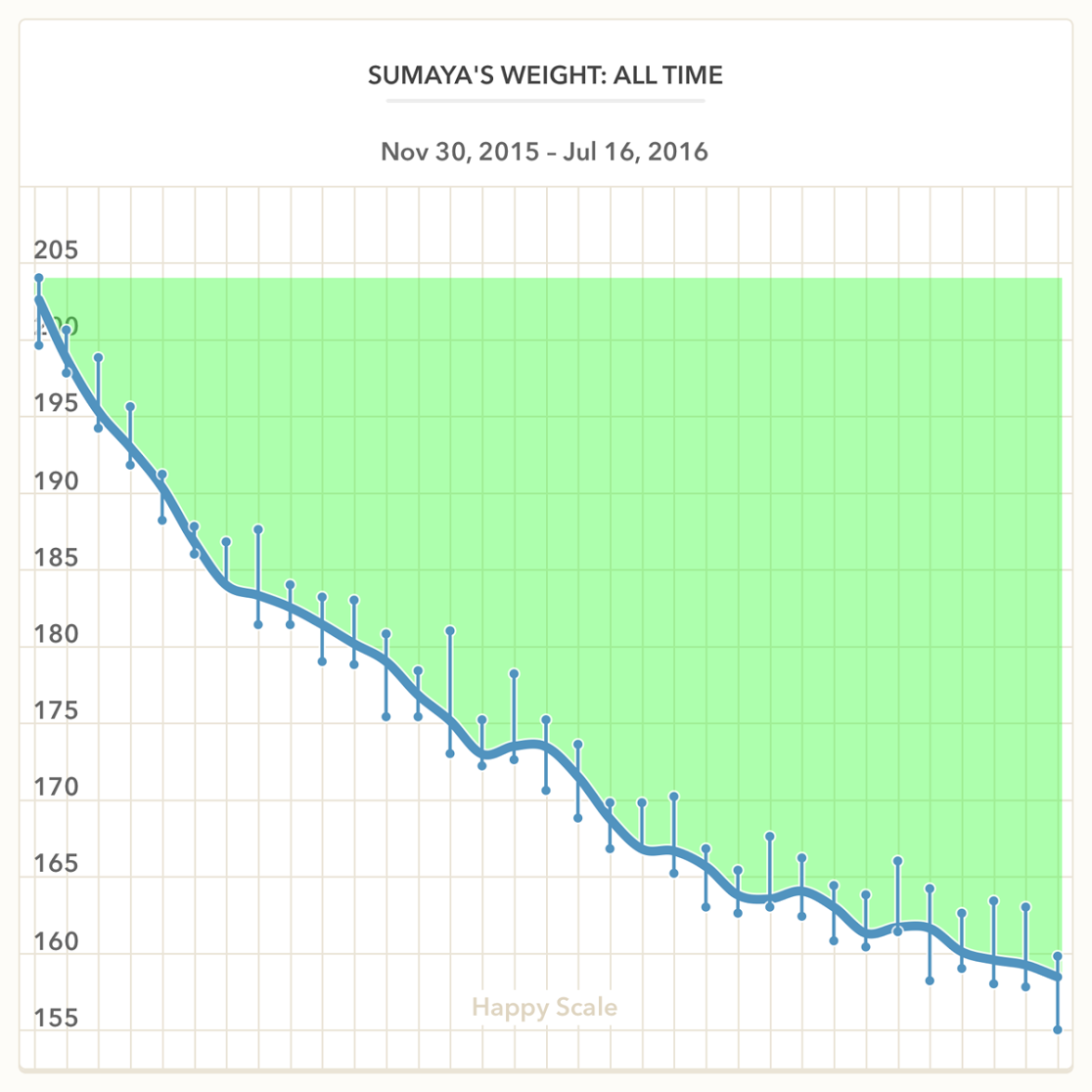 One view (of many) from the Happy Scale App. My progress over the last 7.5 months!
One view (of many) from the Happy Scale App. My progress over the last 7.5 months!
- A scale. I use the Weight Gurus Digital Scale with smartphone tracking. This particular scale measures weight, body fat, muscle mass and more.
- Weight loss tracking app. I love the Happy Scale mobile iOS app (it?s free). It shows how your weight loss is trending, allows you to break your goals down into smaller milestone goals and can predict based on your current weight loss rate when you will hit your goals and more.
The above two are the most helpful and what my friends and I use daily. The below are additional things I?ve done to measure success (but not something you have to do or slow you down from starting IF). I love data, so I choose to do the following as well:
 Early December 2015 vs. Mid-July 2016
Early December 2015 vs. Mid-July 2016
- Visual Progress. Take before photos! You may feel uncomfortable especially when you?re first getting started, but you?ll be thankful for them later.
- Measurements. I also decided to take measurements using a flexible measuring tape when I first started and every four weeks or so. Sometimes the scale doesn?t accurately show all of your progress and photos, and measurements tell a better story.
- MyFitnessPal. I use this app to track my calories on Eat Days (but I don?t use it religiously). I only do this to get a sense of how much I?m eating and make sure I?m eating more than enough on Eat days.
- Detailed spreadsheet. In a spreadsheet I created for myself, I track all of the above and have used it to identify daily/weekly trends and help me figure out how to further experiment with IF. This has been a highly requested spreadsheet, and I hope to share the template in the very near future!
My Style of Intermittent Fasting: The 4:3
I?ve adopted what?s called a 4:3 style of IF. This simply means, I eat 4 days during the week and fast 3 non-consecutive days of the week.
This is what my 4:3 weekly schedule looks like:
SUNDAY: Eat Day // I eat as I normally would throughout the day and I begin my fast at 9 pm PT (this means I stop eating or drinking anything with calories).
MONDAY: Fast Day // On fast days I only drink coffee, tea, non-caloric drinks and water (flavored sparkling water like La Croix has been awesome during fasting, my favorite is the Peach-Pear flavor). I add a little half & half in my coffee, and those are the only calories I consume on fast days. If/when I feel hunger pains on fast days, I drink a bottle/can of sparkling water and that helps me get through the day.
TUESDAY: Eat Day // I break my fast at 9 am PT. I eat my full day of meals. The total calories I eat is my TDEE (total daily energy expenditure) range. I use this tool to calculate my TDEE: https://tdeecalculator.net/index.php I start my fast again at 9 pm PT.
WEDNESDAY: Fast Day // Same as Monday.
THURSDAY: Eat Day // Same as Tuesday.
FRIDAY: Fast Day // Same as Monday & Wednesday.
SATURDAY: Eat Day // Same as Tuesday & Thursday.
SUNDAY: Eat Day // Same as Tuesday, Thursday & Saturday.
In summary: MWF = Fast Days, TuThSaSu = Eat Days. Repeat every week and you will see and feel the difference.
For the visual types, this is what my schedule looks like:

I start my fast at 9 PM and end the day after next at 9 AM, but these time frames can also be changed. Some of my friends prefer 7 PM/7 AM, 8 AM/8 PM, etc. to better accommodate their work/family schedule.
I have found that the 4:3 style fasts have worked well for my friends and me based on our work/life schedule and our personal health goals. I like that full day fasts feel like an on/off switch ? I don?t think about eating on fast days and on eat days if I happen to overeat, I don?t feel guilty about it (since I?m eating at a deficit during the week). I find it more manageable to cut calories over a week (using the 4:3 style of IF) instead of every day (trying to eating less daily).
Tips for the first two weeks
The first couple weeks can feel challenging since your body is trying to adjust but once you get through it, fasting will feel more like a habit.
Watch: 5 Tips to Make Your First Week With Intermittent Fasting Successful
Here are a few tips that helped me:
On Fast Days:
- Having water on hand (especially sparkling water like La Croix) helps a lot
- Let people you see often (friends, family, colleagues) know you?re experimenting with IF. You?ll be surprised how many people will work around your schedule, be supportive and take interest in IF.
- If you need help getting through a Fast day, you can have up to 500 calories to eat without it technically considered breaking your fast. The 500 calories can be used as a crutch to get through the first few fast days. After week 2, you shouldn?t need it.
- If for some reason you do break need to break your fast (and eat more than 500+ calories), count that day as an Eat day and eat your full day?s worth of calories (your TDEE). Don?t try to fast the following day and just stick with your weekly schedule.
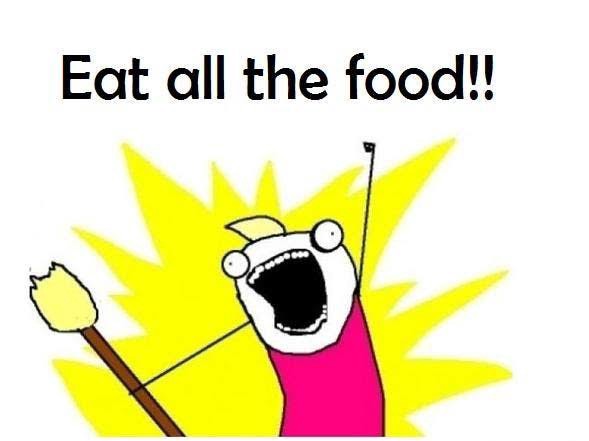
On Eat Days:
- I have found that eating high protein especially during my lunch and dinner meals keeps me better satiated on my fast days.
- It?s super important to EAT your full day?s worth of calories since you are already eating at a deficit on your fast days. Do not skip meals or try to eat less.
Support Networks
Intermittent Fasting can be challenging especially in the beginning which is why having support early on is important. I?m fortunate that my sister, brother and good friends all fast with me now (which makes the lifestyle easier).
I encourage you to introducing IF to a friend, family member or even colleague so that you can experiment with it together! Additionally, there are great support groups on Facebook that I recommend. I?m an admin and active in these groups:
WeFast Intermittent Fasting & Metabolic Performance Community This group includes doctors, specialists in the field, and people who fast for many different reasons including weight loss, biohacking, and living a longer life.
Intermittent Fasting For Women This is a fast-growing group that provides great support for women around the world who are exploring fasting. You can learn from over 80,000 members and counting!
Interested in Fasting with Me? ??
Join my 30-day Starter Challenge or 100-day Lifestyle Challenge. Learn more: http://bit.ly/fastchallenge
That wraps up my quick start guide. I hope this helps you in the right direction!
Based on requests I?ve already started receiving I plan on elaborating more on items above in italics, answering frequently asked questions, sharing tips and discussing topics like the following:
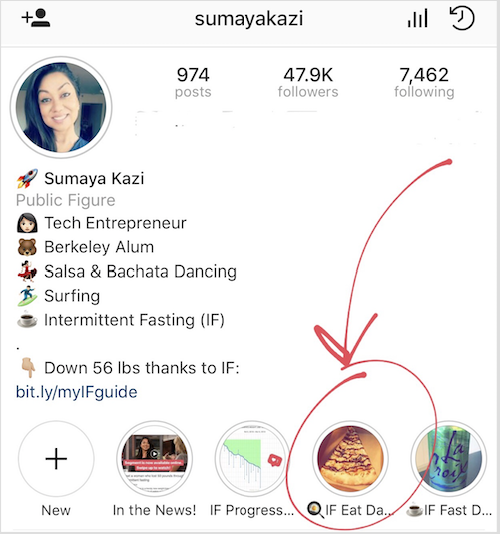
- What do I eat on my eat days (Update: If you?re on Snapchat or Instagram, I?ve been sharing daily updates of what I eat/drink there:
Follow me on Instagram
Follow me on Snapchat
- Tips on how to make the first week successful (Update: Watch me share these tips on YouTube)
- Different styles of IF
- IF and exercise
- How to do IF while traveling or on vacation
- Best practices for IF as a parent or when your partner doesn?t do IF
- Using friends/family as support/accountability networks
- Trends in my data after 7.5 months of IF
- How I feel on eat days and fast days
- Success stories from friends who do IF
- And much more I?m sure!
Intermittent Fasting has changed my life. If it can help just one more person with their struggles and goals, I?m happy to spend the time to answer questions and support you the best I can (and hopefully one day you?ll pay it forward too)!
If you?d like to continue following my IF journey, you can do so by following me on Facebook, Snapchat or Instagram stories.
If you want to receive future posts from me about Intermittent Fasting, feel free to add your email address here: http://bit.ly/IFupdates
A favor:
- If you found this guide to be helpful, please tap the ?? or recommend button below.
- If you think this would be information your friends would be interested, share it on social/email. Easy to share URL: http://bit.ly/myIFguide
- If you have thoughts on how this guide can be improved or have recommendations of what else I can share, let me know! This is the first time I?ve put something like this together, so all feedback is appreciated.
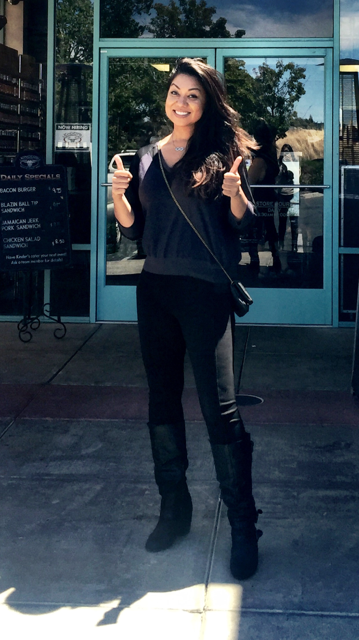
Wishing you the greatest success! ?
Your friend (or friend of friend),
Sumaya
? ?
** Big thanks to Jaya, Tina, Chandni (also IFers) and Lora for their feedback on this guide! ?

